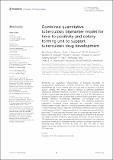Files in this item
Combined quantitative tuberculosis biomarker model for time-to-positivity and colony forming unit to support tuberculosis drug development
Item metadata
| dc.contributor.author | Ayoun Alsoud, Rami | |
| dc.contributor.author | Svensson, Robin J. | |
| dc.contributor.author | Svensson, Elin M. | |
| dc.contributor.author | Gillespie, Stephen H. | |
| dc.contributor.author | Boeree, Martin J. | |
| dc.contributor.author | Diacon, Andreas H. | |
| dc.contributor.author | Dawson, Rodney | |
| dc.contributor.author | Aarnoutse, Rob E. | |
| dc.contributor.author | Simonsson, Ulrika S. H. | |
| dc.date.accessioned | 2023-03-30T15:30:08Z | |
| dc.date.available | 2023-03-30T15:30:08Z | |
| dc.date.issued | 2023-03-14 | |
| dc.identifier | 283923804 | |
| dc.identifier | b2c81d6f-50ba-4d89-8400-ffdbe497393c | |
| dc.identifier | 85151074429 | |
| dc.identifier.citation | Ayoun Alsoud , R , Svensson , R J , Svensson , E M , Gillespie , S H , Boeree , M J , Diacon , A H , Dawson , R , Aarnoutse , R E & Simonsson , U S H 2023 , ' Combined quantitative tuberculosis biomarker model for time-to-positivity and colony forming unit to support tuberculosis drug development ' , Frontiers in Pharmacology , vol. 14 , 1067295 . https://doi.org/10.3389/fphar.2023.1067295 | en |
| dc.identifier.issn | 1663-9812 | |
| dc.identifier.other | Jisc: 985098 | |
| dc.identifier.other | publisher-id: 1067295 | |
| dc.identifier.other | ORCID: /0000-0001-6537-7712/work/132214145 | |
| dc.identifier.uri | https://hdl.handle.net/10023/27304 | |
| dc.description | Funding: This clinical trial was conducted within PanACEA, which was part of the European and Developing Countries Clinical Trials Partnership (EDCTP) 1 programme [project code IP. 2007.32011.012 (HIGHRIF)] and the EDCTP2 programme supported by the European Union (grant number TRIA 2015-1102-PanACEA). | en |
| dc.description.abstract | Biomarkers are quantifiable characteristics of biological processes. In Mycobacterium tuberculosis, common biomarkers used in clinical drug development are colony forming unit (CFU) and time-to-positivity (TTP) from sputum samples. This analysis aimed to develop a combined quantitative tuberculosis biomarker model for CFU and TTP biomarkers for assessing drug efficacy in early bactericidal activity studies. Daily CFU and TTP observations in 83 previously patients with uncomplicated pulmonary tuberculosis after 7 days of different rifampicin monotherapy treatments (10–40 mg/kg) from the HIGHRIF1 study were included in this analysis. The combined quantitative tuberculosis biomarker model employed the Multistate Tuberculosis Pharmacometric model linked to a rifampicin pharmacokinetic model in order to determine drug exposure-response relationships on three bacterial sub-states using both the CFU and TTP data simultaneously. CFU was predicted from the MTP model and TTP was predicted through a time-to-event approach from the TTP model, which was linked to the MTP model through the transfer of all bacterial sub-states in the MTP model to a one bacterial TTP model. The non-linear CFU-TTP relationship over time was well predicted by the final model. The combined quantitative tuberculosis biomarker model provides an efficient approach for assessing drug efficacy informed by both CFU and TTP data in early bactericidal activity studies and to describe the relationship between CFU and TTP over time. | |
| dc.format.extent | 12 | |
| dc.format.extent | 1836538 | |
| dc.language.iso | eng | |
| dc.relation.ispartof | Frontiers in Pharmacology | en |
| dc.subject | Pharmacology | en |
| dc.subject | Rifampicin | en |
| dc.subject | TTP | en |
| dc.subject | CFU | en |
| dc.subject | Tuberculosis | en |
| dc.subject | Biomarker | en |
| dc.subject | RM Therapeutics. Pharmacology | en |
| dc.subject | 3rd-DAS | en |
| dc.subject | SDG 3 - Good Health and Well-being | en |
| dc.subject | MCC | en |
| dc.subject.lcc | RM | en |
| dc.title | Combined quantitative tuberculosis biomarker model for time-to-positivity and colony forming unit to support tuberculosis drug development | en |
| dc.type | Journal article | en |
| dc.contributor.institution | University of St Andrews. School of Medicine | en |
| dc.contributor.institution | University of St Andrews. Sir James Mackenzie Institute for Early Diagnosis | en |
| dc.contributor.institution | University of St Andrews. Centre for Biophotonics | en |
| dc.contributor.institution | University of St Andrews. Biomedical Sciences Research Complex | en |
| dc.contributor.institution | University of St Andrews. Infection and Global Health Division | en |
| dc.contributor.institution | University of St Andrews. Global Health Implementation Group | en |
| dc.identifier.doi | https://doi.org/10.3389/fphar.2023.1067295 | |
| dc.description.status | Peer reviewed | en |
This item appears in the following Collection(s)
Items in the St Andrews Research Repository are protected by copyright, with all rights reserved, unless otherwise indicated.

